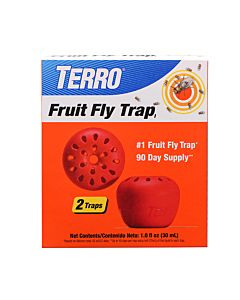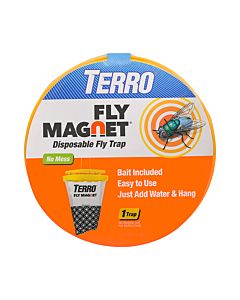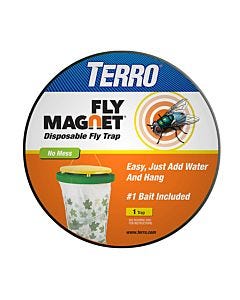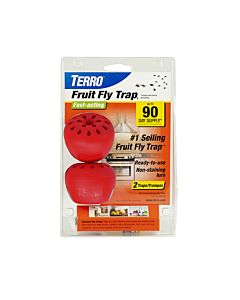How to Deal With a Fruit Fly Problem
For those who have survived a fruit fly infestation, which is most of us during the course of our lives, you understand the determination and perseverance needed to see the battle through to its end. These unwanted invasions can test your patience, but the key to victory is knowing your enemy. If you've found that your problem has grown past the point of homemade remedies, or if you simply don't know enough about fruit flies to combat them effectively, then this article will arm you with the knowledge you need to keep these pests under control!


What are fruit flies?
What they are is the common fruit fly, or Drosophila Melanogaster if you're feeling smart and scientific, and they are frequent household ''guests'' that many of us have had to deal with in our lives. They can be a little tricky to spot at first as they happen to be about as big as the ''B'' in the word ''liberty'' written on a dime. Although small in size, fruit flies are usually fairly easy to spot because they have poor flying skills and can be seen awkwardly flying about.
Where do I find fruit flies?
While at first they may be hard to notice, it won't take long for a fruit fly infestation to grow. It can take less than a week for one of these flies to fully mature, and their lifespan can last the better part of a month. The first step is to identify where they're breeding:

Fruit -
This is their name-brand home. The moment your fruit becomes ripe, and through every moment thereafter, it becomes an insect beacon.

Soda -
The sweet, sticky drink that many of us love becomes a luring signal to the fruit fly once it's been spilled.

Wine/Beer -
Similar to soda, the allure of wine and beer is hard for the fruit fly to resist and serves as a good attractant. Many breweries and vineyards must take extra care against fruit flies, since they can quickly ruin their products.

Garbage -
The true paradise for all insects, and no different for the fruit fly. In fact, the rotting leftovers of our meals is a prime target for these home invaders.
How do I get rid of fruit flies?
There are many ways fruit flies can break into your home. From hitching a ride on the local produce you picked up from the market, to simply finding cracks or improper seals in and around your windows or doors. It can be nearly impossible to deter fruit flies forever, because fruit flies can travel up to six miles a day, and detect strong odors from over 40 kilometers (or just under 25 miles) away!
So here are the basics of how to deal with these pesky bugs:
TERRO® Apple Trap -
Traps like this are perfect to use as a clean and non-toxic way to eradicate your fruit fly problem quickly and effectively.

Fruit fly sources -
The goal is to eliminate potential breeding grounds, such as trash cans, food left out, drinks spilled and damp areas where food has been stored, like pantries.

Disposal -
The first step to getting these pests out of your home is to throw away or refrigerate overly ripened fruits and vegetables. You'll then want to empty trash cans and clean them of any spilled drink remnants or food particles.

Clean up -
Spilled drinks and food residue can continue to draw in more flies, so it's important to wipe down and clean surfaces with which food comes in contact, from the kitchen to the living room. Anywhere you eat is a place they can too!

Unwelcome return -
Diligence is required when using a homemade solution, because eliminating their food source isn't always entirely effective. Fruit flies can continue to breed in soiled mops, dirty drains and used drink containers long after traditional areas have been removed.
Could it be a different type of fly?
Those who have tried our fruit fly trap know how effective they are. However, if it turns out that you don't have a fruit fly infestation, but instead you have a different sort of pest, then our trap won't work! So before beginning to combat these bugs, it's important to know your enemy. With that in mind, there are two other insects commonly mistaken for the fruit fly, the fungus gnat and the drain fly. Below is information to help you identify these pests and tips for dealing with them.guide on how to ID fruit flies, drain flies, and fungus gnats.

What are Fungus Gnats?
If you are encountering small flying insects in your home, there is a chance that they could be fungus gnats. These guys are the same size as the fruit fly, but they have black bodies and long legs, while the fruit fly that has a tan body, red eyes and short legs.
Where do I find Fungus Gnats?
It can be difficult to distinguish these tiny creatures by appearance alone, so understanding the environment in which they reside is essential. You will typically find fungus gnats around moist household plants potted in peat moss soil, and since they are weak fliers, they won't venture far from their homeland.
How do I get rid of Fungus Gnats?
Exterminating fungus gnats can be simple for people with just a few houseplants. If this is your situation, try using these tactics:

Alter your watering schedule -
Aim to keep the top one or two inches of soil dry between watering. Egg-laying females are attracted to the fungus growing in moist soil and the larvae thrive in it.

Repot your plants -
As soil ages, it breaks down and easily retains moisture, so repotting with fresh dirt can help keep things regularly dry.

Sticky gnat cards -
Sticky gnat cards, like Safer® Brands Sticky Stakes, can help eliminate these pests. Place these on the edge of your pot or directly under the plant canopy. By doing this, you capture the egg-laying females, which destroys the larvae that would otherwise be growing in your soil!
For those of you with a greenhouse, dealing with fungus gnats on a much larger scale, you may need to use more drastic measures. If keeping plants dry or repotting is not working for you, try this strategy:
Nematodes -

This is known as an insect parasitic and is biologically safe, so no harsh chemicals are involved! These microscopic roundworms place their attack on the fungus gnat larvae directly by entering through the mouth and digesting their internal contents. Larvae will die off in about four days. The best nematode species to use against fungus gnats is Steinernema feltiae.
These nematodes are simply sprayed onto your plant soil, and some may be diluted with water, depending on the situation or brand.
What are Drain Flies?

The drain fly can be easily mistaken for the fruit fly, but if you can get a good look at your pest, you'll see that the drain fly is appropriately known as the moth fly as well, because they have fuzzy antennae and veined wings similar to that of a moth. If you don't have a magnifying glass on hand, however, a quick and easy way to tell the difference between these flies, is to kill one. If it leaves a black, powdery smudge, then you know it's the drain fly.
Where can I find Drain Flies?
Anywhere that is moist/humid with some organic matter (preferably rotting) can harbor them. Places you should look out for:

Kitchen sink -
This is the area these guys are most commonly found. The damp drain, which may contain leftover food bits, is a paradise for them.

Bathroom drains -
The bathroom sink and shower drain can be common places where hair can build up and begin to rot. While unpleasant to think about, it's another good location for a drain fly infestation.

Cracks and crawlspaces -
Areas where water can pool or leak can be a breeding ground. While undesirable to check, usually this can suggest a leaking pipe, or an area where rain water is getting in.

Outdoors -
While an outdoor area is much more likely to be home to the fungus gnat or the common fruit fly, the drain fly can often compete with them and be found in similar places.
How do I get rid of Drain Flies?
The first step is to verify their source. Take a piece of tape and cover the drain or crack, but make sure to poke holes in them! There must be an air flow, or the flies won't even try to escape. If you find their gross little bodies on the tape later on, you know for a fact that this is their source! If it's in a drain, be sure to clean it of food and slimy residue, both by using a sink brush and an appropriate cleaning agent. Likewise if it's in the bathroom, use a hair clog remover. Just make sure that if you use bleach, which is a very effective way to eliminate drain flies, that you do not mix it with other drain cleaning chemicals. Mixing the two cleaners can cause a chemical reaction, releasing dangerous chlorine gas.
Living fly-free
Dealing with a fruit fly problem is a dirty task from the start. After you successfully get rid of these bugs, taking educated preventative measures to keep them away will save you future grief. Remember to refrigerate overly ripened produce and routinely take out food-containing trash, which will eliminate breeding areas. By knowing this useful information, you can minimize, or prevent altogether, the annoyance that fruit flies can cause in your life.
Not Yet Satisfied?
- Learn more about fruit flies in our Insect Library
- Continue to our Fruit Fly Control Products »





